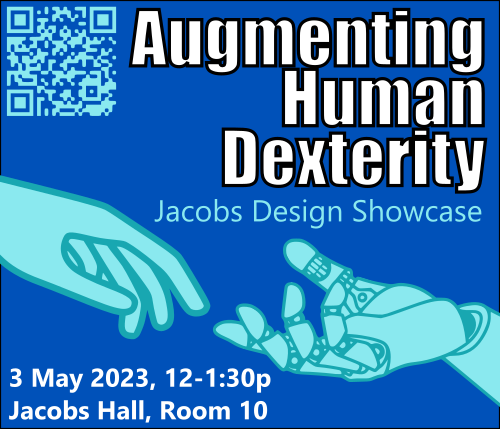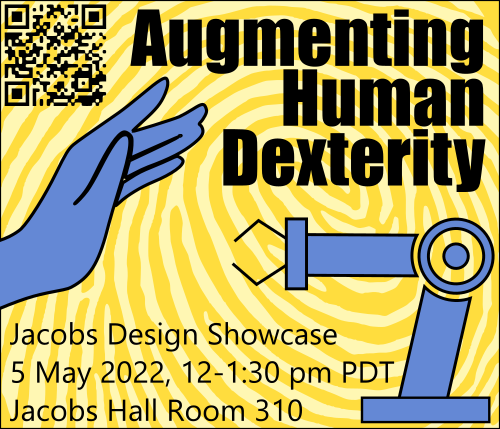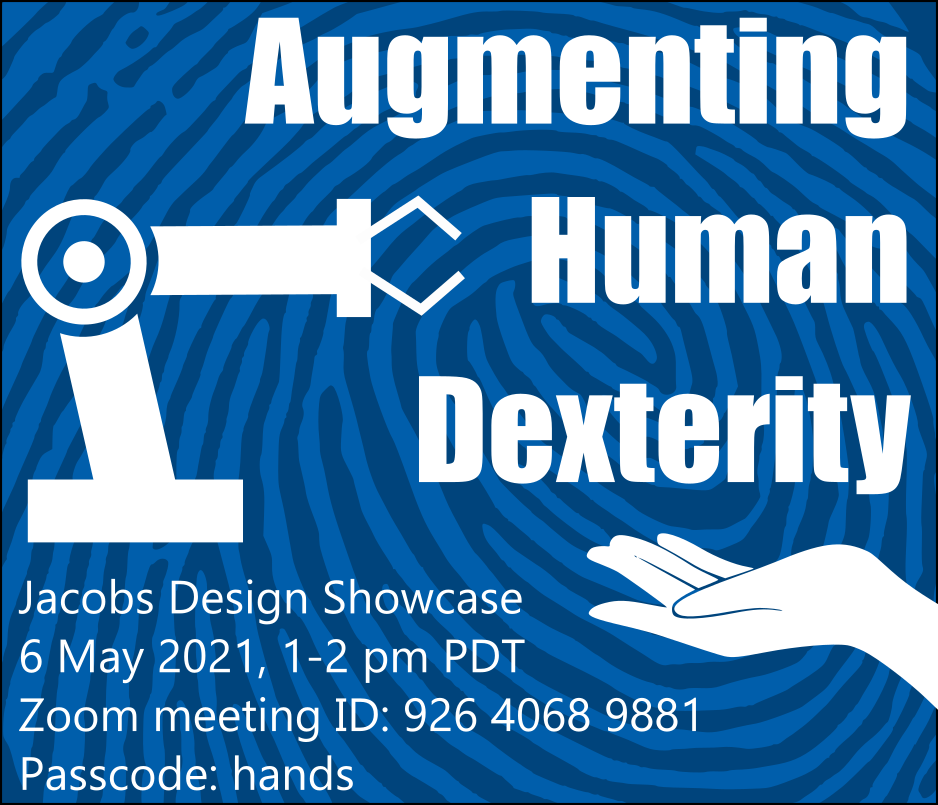Augmenting Human Dexterity
In Aug-Hum-Dex, students learn how to generate physical devices to augment human hands, arms and general dexterity. We start the class by learning to practice need-finding interviews. We then take a deep dive into human hand function and mechanization considerations relevant to smart device design. During the final projects, students utilize human-centered design approaches and read academic literature to develop investigational device concepts.
View project videos at the class’s YouTube Channel.
This is an elective course, taught in the Jacobs Institute for Design Innovation, open to both upper-division undergraduate and graduate students. Both CoE and non-CoE students welcomed!
This class is not being offered in the 2024-2025 academic year.
In this class, students conduct narrative interviews with participants for between 1 to 1.5 hours; this single interview is the only activity necessary to be a “need-knower” volunteer! Students then synthesize a conceptual product design based on that interview for a public showcase. Because this is an educational activity, we cannot guarantee that students will build the device of your choice, nor that the device will function realistically by the end of the semester. That said, the interview can be a rewarding experience in it’s own right and we hope to make it worth your while by providing you with the interview transcript (if you consent to recording) and the end-of-semester report of the project inspired by your experiences. The de-identified report is published online, at this website.
Every person, identity and condition welcome! Everyone uses technology every day, and so there is no specific requirement for interview volunteers. In-person interviews (local) are preferred but not required.
We conducted an education study across two offerings of the course, with results published in the Proceedings of the Americal Society of Engineering Education.
Learn more about this work here: “A case study of student-community interaction through an education-first assistive device design class“
 This semester was fully-in-person, and student team projects focused on need-finding interviews, conceptual ideation, and the development of mechatronic skills to realize a functional prototype.
This semester was fully-in-person, and student team projects focused on need-finding interviews, conceptual ideation, and the development of mechatronic skills to realize a functional prototype.
A live showcase event was in Jacobs Hall room 10 on 3 May 2023 from 12:00 to 1:30 pm. Those attending the live event voted for project awards. Here are the winners:
- Most likely to be commercialized: Team 1
- Best interview narrative: Team 9
- Most compelling scientific study: Team 2
- Most creative device: Team 8
- Most impressive prototype: Team 3
Students will submit written reports summarizing their class projects, and 3 minute videos at this Youtube playlist.
| Forearm Activated Bike Shifter and Braking Mechanism for Safer Hand-Cycling by Team 1: Todd Russell, Lexi Laufer, and Max Ries Report | Fieldwork Orthosis by Team 2: Christian Mast, Julia Tanner, and Roy Yang Report | Body Powered Finger Prosthetic Design by Team 3: Travis Welch and Sangmin Sung Report |
| Newtype Painting System: Preventing Repetitive Strain Injury In Gunpla Painting Hobbyists by Team 4: Boxuan Song, Jiahua Yang, and Romy Mastel Report | Dexterity Project: Twitchy Gamer by Team 5: Cage Zhang, Junkai Shao, and Xinglong Li Report | SoftScribe: Assistive technology to mitigate Writer’s Cramp by Team 6: Anuj Raichura, Derrick Ma, and Phoebe Liu Report |
| LabMate: A Forearm-Mounted Plate Streaking Device by Team 7: Erik Francis, Danielle Hernandez, and Lekha Duvvoori Report | Jar Assistive Clipping Device for Lead Climbers with Limited Dexterity in One Hand by Team 8: Isadora Smith, Colin Wills, and Diego Wong Report | DexPlay: Dampening Wrist Vibrations to Empower Musicians with Essential Tremors by Team 9: Jessica Hsu, Elyse Scalia, and Colin Yang Report |
| Haptic feedback thumb exoskeleton to reduce hypersensitivity and improve pressure feedback by Team 10: Joshua Lin, Shikha Shah, and Neel Shah Report | Automatic Belt Fan for Cooling and Drying Sweaty Hands During Climbs by Team 11: Alexander McNamara, Geneivie Nguyen, and Lovre Soric Report | Enhancing Esports Performance Feedback by Team 12: Alex Eyman, Peggy Tsao, and Jerry Tang Report |
| Hand cycle grips by Team 13: Nana Porter-Honicky and Shila Alizadehghobadi Report | Assitive Bottle Opener for Rheumatoid Arthritis to Decrease Joint Stiffness by Team 14: Ariel Bautista, Johanna Bustamante Salgado, and Erchis Patwardhan Report | Six-Tipped Ergonomic Braille Stylus by Team 15: Daniel Gabriel Dapula and Mridini Vijay Report |
Prior offerings of the course

This semester was fully-in-person! Student team projects focused on need-finding interviews, conceptual ideation and background literature, as well as the skills to physically realize a functional prototype.
A live showcase event is in-person only in Jacobs Hall room 310 on 5 May 2022 from 12:00 to 1:30 pm. Those attending the live event voted for project awards (winners indicated below).
- Most likely to be commercialized: Team 7
- Best interview narrative: Team 15
- Most compelling evaluation study: Team 14
- Most creative device: Team 10
- Most impressive prototype: Team 4 and Team 7 (co-awarded)
Students submitted written reports summarizing their class projects, which are posted below, and 3 minute videos on this YouTube Playlist.
| Physical Therapy Device for Shoulder Range of Motion Recovery by Team 1: Yarah Feteih, Shanon Lee, and Ingrid Shan Report | Happy Garden: Easy Gardening Tools by Team 2: Xinwei Chen, Yue Feng, and Yang Wu Report | The Warm Up by Team 3: Rafi Hanafiah and Jesse Thiara Report |
| FlexFix: Finger tracking and notification system for hypermobility and osteoarthritis by Team 4: Josephine Koe, Joseph Macy, Roland Saekow Report Most impressive prototype. | The Bear Paw: A Quick-Release Wearable Device to Assist Transmetacarpal Amputees by Team 5: Henar Urteaga Juangarcia, Kallai Hokanson, and Zach Lima Report | Fashionable 3D Printed Wrist Support for Young Adults with Rheumatoid Arthritis by Team 6: Jennifer Farmerie, Marine Sanosyan, and Elise Scipioni Report |
| Designing an Augmented MIDI Keyboard for a Musician with Amniotic Band Syndrome by Team 7: Zach Christiansen, Justin Oshiro, and Brittany Powell Report Most likely to be commercialized & Most impressive prototype. | Jar Opening Device for Humans with Rheumatoid Arthritis by Team 8: Adeen Bilal, Benjamin Lowe, and Matthew Wong Report | SMOOTH: Reducing Hand Discomfort from Smartphone Overuse with a Control Ring by Team 9: Adia Hu, Roo Yan, and Jingan Zhang Report |
| Shape Memory Alloy (SMA) Assistive Technology to Mitigate Repetitive Strain Injury by Team 10: Adit Roychowdhury and Janek de Silva Report Most creative device. | Tendon support for continued training with climbing-related A2 finger pulley injury by Team 11: Shaantam Chawla, Morgan LaMarca, Sheila Murthy Report | Improving Range of Motion of Symbrachydactyly through Finger Exoskeletons with Vibrotactile Feedback by Team 12: Alex Orr, Elianna Peng, and Yuqing Wang Report |
| Post Stroke Balance Augmentation Device to Incentives Return to Active Hobbies During Recovery by Team 13: Ramyani Roy and Ionatan Werner Report | Assisting Partial Hand Amputees with Grasping Soft Objects by Team 14: Sam Cribbs, Musaiel Gebremariam, and Brendan White Report Most compelling evaluation study. | Investigating A Notifying Utensil for the Eating Needs of People with Cerebral Palsy by Team 15: James Nguyen and Debbie Yuen Report Best interview narrative. |
| Symptom tracking glove for Rheumatoid Arthritis and Secondary Raynaud’s by Team 16: Chirasree Mandal and Sneh Jandial Report | Creating a Device for Easier Trail Surveying for Users With Quadriplegia by Team 17: Benal Johnson and Nimit Baid Report | Assistive Shaker for Bartenders to Reduce Occupational Wrist Strain by Team 18: Austin Nguyen, Lezhou Ma, and Ruhika Lankalapalli Report |

This semester was fully-virtual due to COVID-19 Shelter-in-Place, so the student team projects focused on need-finding interviews, conceptual ideation and background literature — skills that could be readily practiced remotely. Significant physical realization was not required, although some teams opted to do so anyway. Students summited written reports and 3 minute videos summarizing their class projects, available below.
The live showcase event was on Zoom on 6 May 2021 from 1:00 to 2:00 PDT on Zoom. Participants got the chance to watch the videos streamed live while asking questions of the students via interactive Q&A chats on Padlet: https://padlet.com/hstuart9/AHD2021
Those attending the live event voted for project awards (winners indicated below).
- Most likely to be commercialized: Team 8
- Best interview narrative: Team 6 and Team 12 (co-awarded)
- Most compelling scientific study: Team 3
- Most creative device: Team 12
- Most impressive prototype: Team 5
Student presentations can be watched at this YouTube Playlist.
| Development of a Palmar, Localized Haptic Array for Virtual Reality Applications by Team 1: Nicholas Callegari, Katie Henshaw, Heya Kaakeh | Lowered Dexterity in Gaming by Team 2: Arsany Gad, Xiangjiu Wu, Samantha Yang Report |
| Mirror Therapy Augmentation by EMG-EStim Treatment by Team 3: Marcie Diamond, Jared Farley, Priya Vijayakumar Report Most compelling scientific study. | Breathable Splint Design for Carpal Tunnel Syndrome by Team 4: Ivy Chan, Natali Gallegos, and Michelle Ramirez Report |
| Attenuation of resting tremors via PID control by Team 5: Ashley Reilly, Frederick Houghton Report Most impressive prototype. | Less Twisting, Better Teeth: Ergonomic Design for Endodontist Tools by Team 6: Justin Radatti, Loren Lee, and Nikhil Gupta Report Best interview narrative. |
| Over-Use Warning Glove for Carpal Tunnel Syndrome by Team 7: Mariam Ayrapetyan, Wenny Miao, Kellen O’Rourke Report | Comfort Controller Design for Improved Computer Video Gaming by Team 8: Dominic Melville, Erin Chang, and Jungpyo Lee Report Most likely to be commercialized. |
| Supernumerary Enhancement For Hemiparesis by Team 9: John John Huddleston, Adam Saleh, and Bryan Wong Report | IMU-Controlled Soft Orthotic for Power Grasping by Team 10: Drew McPherson, Jason Torres, Anna Wolfe Report |
| Addressing Dexterity Challenges in the Classroom by Team 11: Ian Miller, Dunja Panic, and Xiaolin Wang Report | Managing the Effects of Hyperhidrosis through Targeted Air Flow Application by Team 12: Miyuki Weldon and Franziska Barthel Report Best interview narrative & Most creative device. |
| A Preventative Solution for Repetitive Strain Injury by Team 13: Andrew Plewe, Paul Hsiao, and Tony Ngo Report | Increased Hand Function Confidence after Ischemic Stroke by Team 14: Winnie Lai, Haohong Lin, and Himani Patel Report |
Each project team presents their proposed study for 12 minutes; you can find the recordings at this YouTube playlist (there are a total of 9 teams each with 2-3 people). This is part of the Jacob’s Design Showcase, which is hosted remotely this year due to COVID-19. We hope that you enjoy these videos. This year, attendees were able to join us for a live interactive Q&A event on May 7 from 10a-11a on Zoom.
| Welcome -- Prof. Hannah Stuart | Project Grip: A Gamer's Passive Ergonomic Solution to Hand Fatigue and Pain -- Julian and Robert |
| Improved Grasping Ability in Tenosynovitis Patients through Increased Friction -- Renuka and Charit | Wheelchair Pressure Mapping and Alert System -- Anthony, Julie and Kristina |
| Piano Pedagogy Biofeedback Device -- Oliver and Leo | Improving Composition Ability for People with Short-term Arm Injuries -- Kristen and Ryan |
| A Novel Forearm Cuff for C6 SCI Patients -- Erik and Cameron | Automated Mattress Tilter: Redistributing Pressure to Reduce Bed Sores -- Carina, Hope and Bryant |
| EEG-EMG based BCI Controlled Upper-LImb Exoskeleton for Rehabilitation -- Kyelo, Annie and Ella | Parkinson's Project Proposal -- Moriah and Ross |
Two projects addressed the design of a prosthetic hand for Theo, a 5 year old. Here is some footage of these devices during the Jacobs Design Showcase.
